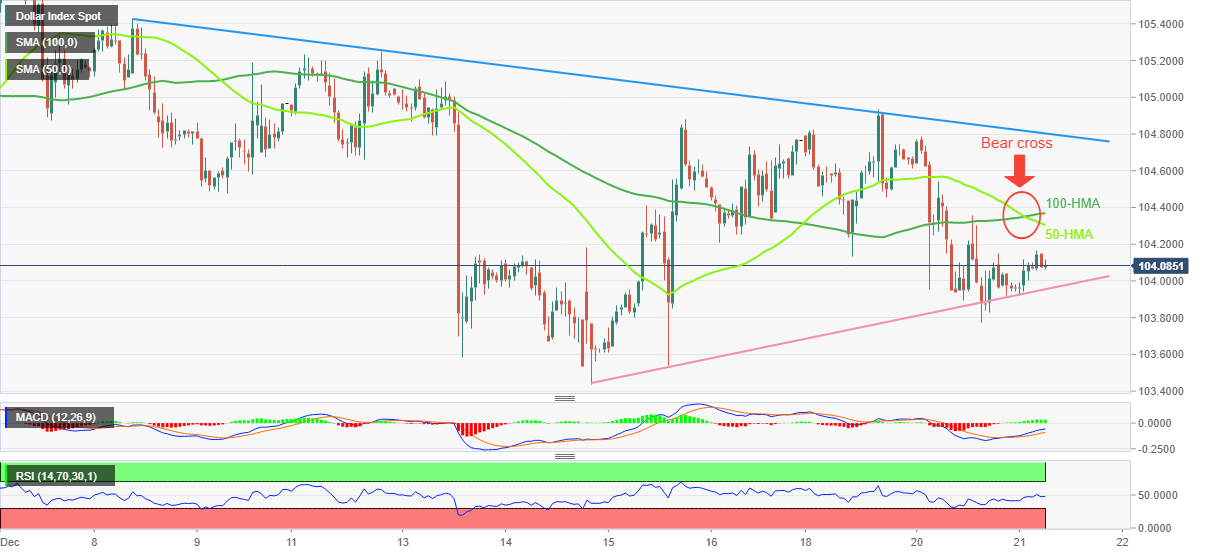- US Dollar Index grinds lower after bouncing off weekly bottom.
- DXY struggles as United States Treasury bond yields stay firmer but yield curve inversion recedes.
- US Conference Board Consumer Confidence eyed for intraday directions ahead of Federal Reserve’s preferred inflation.
- US Dollar’s gauge bounces off one-week-old support but bear cross keeps sellers hopeful.
US Dollar Index (DXY) licks its wounds around 104.10 during early Thursday. In doing so, the greenback’s gauge versus the six major currencies print the first daily gains in three, also consolidating the biggest fall in a week, as the United States Treasury bond yields remain firmer despite the latest consolidation in the market.
United States Treasury bond yields keep US Dollar Index firmer
The US Treasury bond yields remain firmer even as the stocks and other riskier assets trim recent gains, which in turn underpin the US Dollar Index (DXY) strength. The reason could be linked to the cautious mood ahead of today’s US Conference Board (CB) Consumer Confidence figures for December, expected at 101.00 versus 100.00 prior.
It’s worth noting that the DXY dropped the most in a week the previous day as the greenback traders feared less Japanese bond-buying of the US Treasury bonds due to the Bank of Japan (BOJ) action. Japan is the biggest holder of the US Treasury bonds and the latest move allows Tokyo to put more funds into the nation than letting it flow outside.
Yield curve inversion, cautious optimism weighs on DXY
United States Treasury bond yields rallied the previous day but the 10-year yields rose more than the two-year ones and hence reduced the yield curve inversion that suggests the receding odds of the recession and can weigh on the US Dollar Index (DXY). That said, the US 10-year Treasury yields grind near a three-week high of 3.69% while the two-year bond coupons stay firmer around 4.26% by the press time.
Elsewhere, hopes for China’s more investment, due to the World Bank’s cutting of growth forecasts for the dragon nation and the policymakers’ readiness to battle the recession fears, favor the market sentiment and weigh on US Dollar Index. On the same line could be the US Senate’s advancement of the $1.66 trillion government spending bill, as well as Japan’s upbeat economic forecasts.
US CB Consumer Confidence, risk catalysts eyed
Looking forward, an anticipated strength of the US Conference Board (CB) Consumer Confidence figures for December, expected at 101.00 versus 100.00 prior, could propel the US Dollar Index (DXY) amid sluggish markets. However, risk catalysts are also important for clear directions. Among them, headlines surrounding China, Japan and bond markets will be important. It's worth noting that the Federal Reserve's preferred inflation gauge, namely US Core Personal Consumption Expenditure (PCE) Price Index for November, expected 4.6% YoY versus 5.0% prior, appears this week's key even to watch for the DXY traders as hawks at the United States central bank seem to retreat as of late.
US Dollar Index technical analysis
US Dollar Index (DXY) bounces off a one-week-old ascending support line to portray the latest consolidation.
However, the 50-Hour Moving Average (HMA), pierces off the 100-HMA from above to portray the bear cross and suggest further downside of the greenback’s gauge versus six major currencies.
As a result, the aforementioned support line near 103.95 gains the major attention of the DXY traders as a break of which could quickly drag the US Dollar Index towards the monthly low of 103.43.
In a case where the DXY remains bearish past 103.43, the 103.00 and 102.00 round figures could entertain traders before highlighting May’s low near 101.30.
On the flip side, the previously mentioned HMAs guard the immediate upside of the US Dollar Index near 104.30-35.
Following that, a downward-sloping trend line from December 08, close to 104.80 by the press time, will be crucial for the DXY traders as a break of which will give control to the bulls.
Overall, DXY remains bearish despite the latest rebound.
US Dollar Index: Hourly chart
Trend: Further downside expected
Information on these pages contains forward-looking statements that involve risks and uncertainties. Markets and instruments profiled on this page are for informational purposes only and should not in any way come across as a recommendation to buy or sell in these assets. You should do your own thorough research before making any investment decisions. FXStreet does not in any way guarantee that this information is free from mistakes, errors, or material misstatements. It also does not guarantee that this information is of a timely nature. Investing in Open Markets involves a great deal of risk, including the loss of all or a portion of your investment, as well as emotional distress. All risks, losses and costs associated with investing, including total loss of principal, are your responsibility. The views and opinions expressed in this article are those of the authors and do not necessarily reflect the official policy or position of FXStreet nor its advertisers. The author will not be held responsible for information that is found at the end of links posted on this page.
If not otherwise explicitly mentioned in the body of the article, at the time of writing, the author has no position in any stock mentioned in this article and no business relationship with any company mentioned. The author has not received compensation for writing this article, other than from FXStreet.
FXStreet and the author do not provide personalized recommendations. The author makes no representations as to the accuracy, completeness, or suitability of this information. FXStreet and the author will not be liable for any errors, omissions or any losses, injuries or damages arising from this information and its display or use. Errors and omissions excepted.
The author and FXStreet are not registered investment advisors and nothing in this article is intended to be investment advice.
Recommended content
Editors’ Picks

EUR/USD holds losses below 1.1400 amid US Dollar recovery
EUR/USD remains pressured below 1.1400 in the European trading hours on Tuesday. The Euro weakens amid rising expectations of further ECB interest rate cuts while the US Dollar draws support from some progress on US trade deals with its major global trading partners. US jobs data awaited.

GBP/USD retreats to near 1.3400 ahead of BoE’s Ramsden speech
GBP/USD is holding its pullback from three-year highs of 1.3445 early Tuesday, pressured by a modest US Dollar rebound and a cautious market mood. Investors look to BoE policymaker Ramsden's speech and US jobs and consumer sentiment data for fresh trading impetus.

Gold price retains negative bias amid positive risk tone and reviving USD demand
Gold price remains heavily offered through the early European session, though it manages to hold above the $3,300 mark amid mixed fundamental cues. Signs of easing US-China trade tensions continue to drive flows away from traditional safe-haven assets and undermine demand for the precious metal.

Tether Bitcoin stash crosses 100,000, stablecoin giant holds 7.7 tons of physical Gold
Tether, a stablecoin giant and the seventh-largest holder of US Treasury bills, published its attestation report for the first quarter on Monday. The stablecoin firm noted the US Dollar’s (USD) dominance in the stablecoin sector and dropped the statistics on its physical Gold reserves.

Week ahead: US GDP, inflation and jobs in focus amid tariff mess – BoJ meets
Barrage of US data to shed light on US economy as tariff war heats up. GDP, PCE inflation and nonfarm payrolls reports to headline the week. Bank of Japan to hold rates but may downgrade growth outlook. Eurozone and Australian CPI also on the agenda, Canadians go to the polls.

The Best brokers to trade EUR/USD
SPONSORED Discover the top brokers for trading EUR/USD in 2025. Our list features brokers with competitive spreads, fast execution, and powerful platforms. Whether you're a beginner or an expert, find the right partner to navigate the dynamic Forex market.




